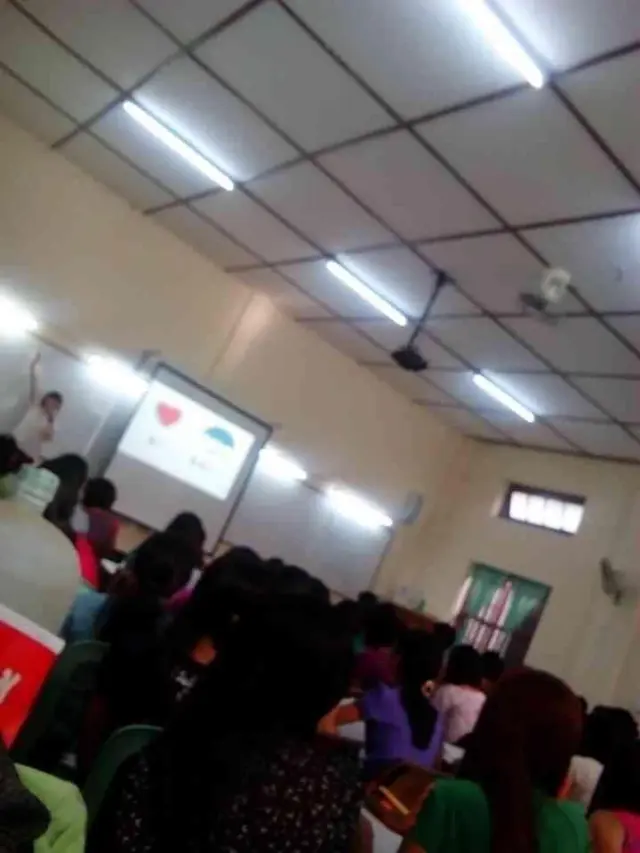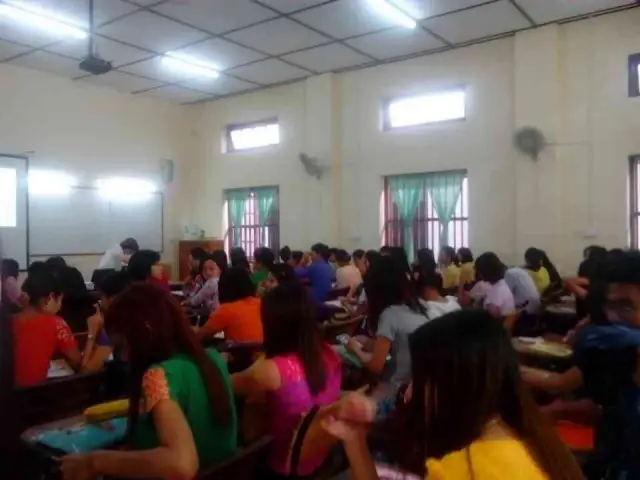2015 Activity Report
■■■News From the Japanese Classroom (March, 2016)■■■
On the 3rd of March was the level 1 end of semester exam and on the 4th of March was the level 2 class mid-term exam.
As expected, students with good attendance scored well on the tests from both the level 1 class (started from zero in December) and the level 2 class (group with previous experience).
Students who attend classes every time and continue to study diligently have a strong willingness to study abroad in Japan. Whenever there is a chance to discuss such topics as the current issues in Japan and popular young culture trends (Interpretation provided by teaching assistant), the students seem to listen intently.
When talking about the price of commodities in Japan, they were shocked at how expensive things were. Also, the students showed their interest by enthusiastically listening to the Japanese society explanations such as trains running exactly on time and very rarely arriving or departing late. It can be said that within the country of Myanmar the social conditions of Japan are still mainly unknown and regarding Japanese language education, conducting Japanese language classes goes without saying but as well as the normal Japanese language education, I thought that providing students with interesting information regarding Japanese culture and society is very important.
On the 7th (Mon) and 8th (Tue) of March we held the classes for the return of the exam and the “Japanese Culture Introduction”. For the culture class I introduced “Yukata” and “Origami”.
Teachers brought one male and one female yukata and a Japanese student studying abroad at Yangon University brought another female yukata so we conducted the “Japanese Summer Traditional Clothing Introduction” with a total of 3 yukata.
Firstly, we introduced how to put on the yukata. We explained that usually you do not wear anything under a yukata but this time, we had them wear the yukata over their traditional clothes and showed them how to tie a bunko-musubi knot (a style for tying the obi or belt).
Following this, we proceeded to the “Yukata Experience” section. Since there were only 3 yukata for 20 students so we got the students to get into groups of 3 and divided them into a further 2 groups, one to try on the yukata and another to experience origami. The foreign student from Japan was in the class as a Japanese education assistant and was kind enough to help others putting on the yukata and teaching the students how to do origami. There were many students who had never worn a yukata before and so everyone was taking photos with their Iphones, taking pictures of their friends, taking pictures together and even posing like film stars whilst enjoying wearing the yukata. At the origami class we introduced how to make cranes and a helmet.
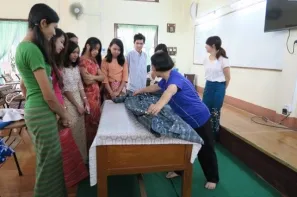
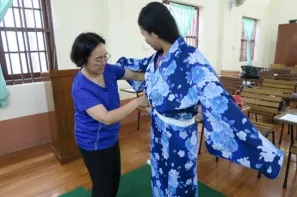
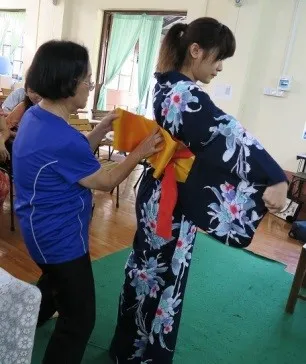
The class with previous experience held a speech presentation at the end. Regarding the task of using the grammar patterns that they have learned so far to do a speech, everyone was able to skillfully complete a self-introduction and talk about their hopes to study abroad in Japan.
The teacher said “By the next semester I am looking forward to seeing further improvement of your Japanese.” After which we thought we would bring the session to a close but then out of nowhere, we suddenly had an opportunity to experience the culture of Myanmar.
For the first time we received a “worship towards the teachers” which is a local custom here.
Here in Myanmar everyone religiously visits temple and in front of a Buddha statue and gracefully devotes prayer. Also, not only to the Buddha, but they also worship the high priest. I already knew this but the “worship culture” of Myanmar is also established within the household. From a young age children honor their parents and from time to time worship their parents just like they would the Buddha.
The method of conducting worship is as follows. 1). Sit straight and bring your hands together. 2). Bring your hands up to your forehead. 3). Bring your hands down to the floor then fold at the waist until your head touches the floor as you bow. 4). Repeat the above 3 times.
The people of Myanmar worship their parents during the time of the Buddhist Thadingyut festival after the rainy sason, they also worship the people they respect and who have helped them in some way. There is a custom that students worship teachers who they especially respect or have been in the care of as a whole class at the end of a semester.
In Japan, teachers are respected but there is no custom of worshiping them like worshiping to a Buddha. So when the students gathered around the teacher in a semi-circle formation and began lowering their heads to the floor, bringing their hands together and worshiping the teacher just like they would the Buddha, as a teacher it was both very appreciated but also embarrassing.
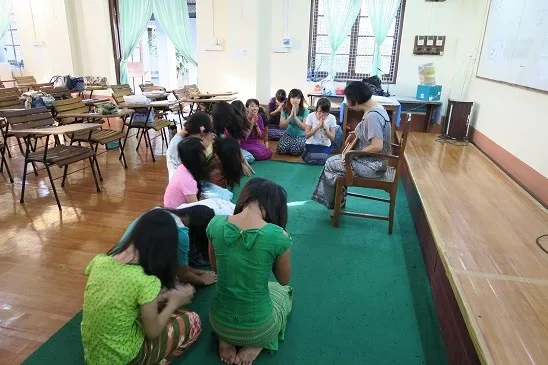
Anyway, roughly 3 months after the start of the new semester we held this class and at the end of the semester we were overwhelmed to receive a gesture such as this. As we were not sure what to do when receiving worship, we just brought our hands together and said “thank you”.
According to the teaching staff at the university, worship is not carried out for every teacher, only to those who the students feel especially grateful towards will receive worship. For the students to spontaneously begin to worship is proof that the GJO Japanese class is well thought of and has been greatly welcomed by the students. I would like to record this in this diary and end the current semester on a high note.
■■■News From the Japanese Classroom (February, 2016)■■■
On the 1st of February (Mon) the mid-term test was held for the level 1 class and on the 2nd (Tue) the mid-term test was held for the level 2 class. For the level 1 class, I conducted a Japanese language test that complied with the N Test format however, many of the students who are used to memorizing the whole page of information and re-writing it for exams are not accustomed to the N Test standard format, in order for them to get used to it, we set practice questions in January prior to the test which included choosing the correct particle questions, short sentence composition, reading comprehension questions and so on. Out of all the students who took the test, the students with good attendance did really well.
By mid-February students who did not do well on the mid-term test from both levels 1 and 2 unfortunately showed a tendency to give up on continuing with their studies and by the end there were just over 20 students in level 1. In level 2 18 students continued to attend. In addition to normal classes, I have distributed more practice questions to get the students prepared for the end of term tests both during class and as homework and continued practice to get the students accustomed to the new exam format.
Students who attend classes every time and continue to study diligently have a strong willingness to study abroad in Japan. Whenever there is a chance to discuss such topics as the current issues in Japan and popular young culture trends (Interpretation provided by teaching assistant), the students seem to listen intently.
When I start talking about the price of commodities in Japan, students were shocked to hear that 1 bottle of water costs 100 yen or 1000Ks and there were also students shocked to hear that one bowl of ramen costs as much as 300 to 400 yen.
Also, when teaching numbers I introduced the notes and coins of Japan and there were some students who had never seen Japanese money before. It can be said that within the country of Myanmar the social conditions of Japan are still mainly unknown and regarding Japanese language education, conducting Japanese language classes goes without saying but as well as the normal Japanese language education, I thought that providing students with interesting information regarding Japanese culture and society is very important.
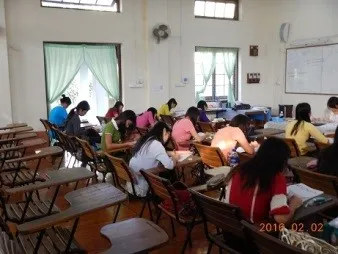
■■■News From the Japanese Classroom (January, 2016)■■■
The New Year holiday period in Yangon does not have a New Year’s Eve or New Year’s Day. Companies and government offices have work as usual. I knew that there was no New Year`s Eve but I thought they would rest on New Year`s day so I really felt a difference in culture. Here in Yangon the New Year starts in April. It is grandly celebrated with such events and festivals as the Thingyan Festival(water festival).
On the 31st of December, I bumped into the Department Chairman on the stairs who said “The Literature Department is having a welcoming party for the new students, please attend”. As the students from the Literature Department will lessen in number, I decided to change the level 1 (class with no prior knowledge) Japanese language class to a “Hiragana Revision” class, in which we held a Karuta (traditional card game) competition. I have only just introduced hiragana so I was a little worried about how the students would cope but I decided to introduce the game anyway as it was also a good opportunity to introduce the Japanese New Year and one of the traditional games played at this time of year.
There were 5 sets of Hiragana cards to use between 35 participants so we split them into groups of 7, placed only the sounds of the card on top of the cards and had the students take the card of the word read aloud by the teacher. Words were read out like “Inu, I, I, I (dog)”, “Kasa, ka, ka, ka (umbrella)” and “kutsu, ku, ku, ku (shoe)” however, for the students who have only just learned hiragana it was a tough exercise and the students had trouble distinguishing 「い」 and 「こ」 and not recognizing the differences between 「れ」, 「ね」 and 「わ」. Though despite this, the students seemed to appear to enjoy taking part in the game and had a great time without even noticing the karaoke competition that was going on outside. In a Karuta game with 50 sounds, a student that collected 17 cards became the champion.
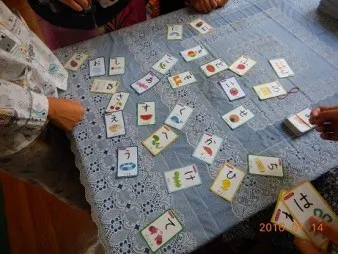
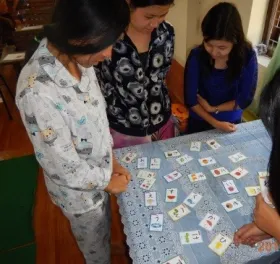
At the end of January I conducted a hiragana test. This was mainly because on reflection, for the students that started learning from scratch in June they never quite got accustomed to both “Hiragana” and “Katakana”. In the last academic year the main objective of this class was to “Enjoy Experiencing Japanese language” but now at each turning point I am conducting “Hiragana” and “Katakana” tests. As for the results of the hiragana test for which I gave previous notice, practice questions and made sure they knew the test format, almost all students scored over 80% which was a great set of results.
The level 2 class (students with prior knowledge) has started to learn kanji. Starting with letters which originally came from hieroglyphs such as mountain and river then moving onto ideograph letters such “women like children. So when you combine the letter for woman and the letter for child together, it makes the letter like”. Everyone is enjoying tackling the challenge of learning kanji. Perhaps because their eyes are used to reading the complex shapes of the letters of Myanmar but they seem to recognize the shape of similar letters better than students who are used to using the alphabet. For example they were quickly able to grasp the differences between the kanji for big, dog and thick (which are all very similar kanji). The students say that “Kanji is difficult but it is interesting”.
After learning the kanji for the number 1, I introduced “1 month and 1 day” and the special kanji readings that applied. Learning kanji is a great hurdle within learning the Japanese language but I believe the enthusiastic students will try their best.
■■■News From the Japanese Classroom (December)■■■
The new term will start in December at Yangon University. The students will be arriving from their hometowns and from Yangon city assembling at the University and the new students will be registering for their classes. The entrance ceremony for the new students in the literature department was held of the 10th of December, however there was no calendar specifying when the opening ceremony was or when the deadline for course registration was for example, so it seems both students and teachers will have to rely only on word of mouth to individually gather information and then act accordingly. We asked students from TUFS who are participating in the year abroad exchange program and are studying Burmese at Yangon University, who said they will ask the relevant teachers when the classes start and then exchange that information among other students.
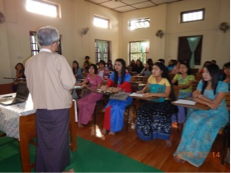
A look at the level 1 class, course explanation given by Mr. Okuhira
The registration for the Japanese classes took place at the counter of the Japanese literature department. Until September 2015 there were two classes, one that had already started learning Japanese (Level 2), and one that was about to start learning Japanese (Level 1). In September at the beginning of the new term, due to the fact that few students heard the announcement regarding the planned level test (placement test), four revision classes were provided over two weeks for the level 2 students after which the placement test took place on chapters 1-6. Out of 38 students that registered, 18 passed, 2 had to re-take but also passed. The deadline for the level 1 course is now the 11th of December. The Japanese Literature Department manager requested that out of the 120 students who registered, that a class of 50 students should be organized and the selection process for the level 1 class was held. Before the placement test, a class on Katakana was carried out and an exam on Katakana and then an essay to be written in Burmese titled “Why I am interested in Japan”, according to these tests 40 students passed and 12 students were given permission to advance on the re-test. The classes began from the 4th week of December and everyone is attending the classes full of enthusiasm.
Since there is no University calendar, the local custom here is that event announcements are made on the day. The Global Japan Office (GJO) was not informed about the University closing on the 18th of December due to the University’s science department festival, and so continued to make preparations for regular classes. To find out whether you had classes or not, the students that followed the University`s policy of individually visiting each teacher and asking for confirmation will probably attend University. However, students believing the information that the University will be closed almost certainly will not come to classes. The students who did not attend classes because of the closure and who had progressed through the Japanese learning part of the textbook would be at a disadvantage. Students who had confirmed with the teachers and attended University believing they had classes will be disappointed.
Therefore on the 18th of December, using this as an opportunity, we decided to conduct a “Japanese Culture Class” where 2 of the foreign exchange students from TUFS helped carry out a special lecture “Japanese Culture, women’s games”. Exchange students Ms. Shimazaki and Ms. Hisamune gave a demonstration of a hand game melody called “10,000ft in the Alps”. One of the teachers from Yangon University introduced the Myanmar version of rock, paper scissors (tiger, king, gun), there was also juggling bags and other such activities and it became a fun cultural exchange. The final cultural introduction was origami. Everyone picked one colored piece of paper and made a crane.

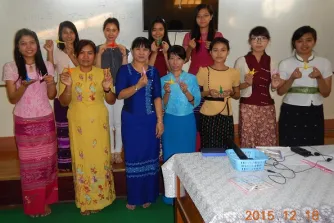
On Sunday the 13th of December, the Japanese culture festival “Japan Pueto” which was sponsored by the Japanese embassy and Yangon Japanese association was held. A large number of Yangon residents gathered for the festival introducing Japanese culture and enjoyed showings of Japanese martial arts, and other activities such as the chance to try on a kimono.
Also inside, the International exchange fund “Japanese language partners” Mr. Suzuki who works as the Japanese language education assistant at Yangon University of foreign studies put on a splendid Japanese drum performance which was one of the highlights. Mr. Suzuki is a 4th year student from TUFS who is majoring in Burmese. Taking a year out and contributing to the Japanese language education here, what is even more impressive is that for 20 years, since the age of 5 he has continued to contribute to the cultural exchange between Japan and Myanmar through his Japanese drum performances. It makes me happy knowing that TUFS students like Mr. Suzuki are playing an active part in Japanese language education and cultural exchange in various regions around the world.
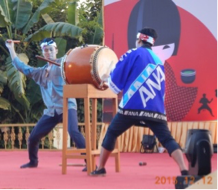
Japanese drum performance by 4th year Burmese major Mr. Suzuki
■■■News From the Japanese Classroom (September)■■■
The University of Yangon will hold their final examinations this September. The students’ voices are sure to grow hoarse after completing their exams, the reason being that memorization is the core focus of their exam revision. In order for them to memorize their work, the students copy out the notes written in their textbooks and then remember what they have written by reciting them. The hoarser the students’ voices are the more they will recite, meaning they can obtain a good grade.
A class titled “Course on Final Exam Counter-measures” was opened at the end of August. All students who are concerned wondering “Which parts in the textbook will appear in the exam?” attend this class from 3:30pm-5:00pm. Unfortunately, the class is held at the same time as their Japanese language classes. As a result, the number of students attending Japanese lectures has fallen considerably since the end of August. Since September, the number of enrolled students attending the lectures has dropped to a mere 1 to 2 students, and lecturers have continued teaching their own classes.
On Tuesdays and Fridays from September, Japanese classes will begin for science teachers at the University of Yangon as research from Japan has been dispatched. Teaching materials are prepared in Romaji and texts are provided and used in Burmese. Luckily, the texts are familiar to the students and easy to understand, which has led to everyone actively participating in lessons.
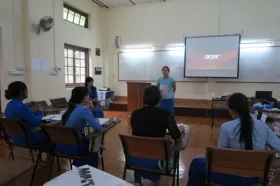
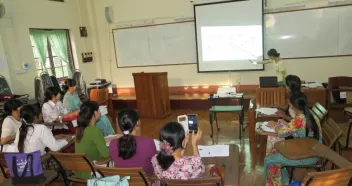
Although each of the six classes lasted only 90 minutes, each student who attended was able to give a self-introduction by the end. “I am a lecturer here at the University of Yangon. I am researching biology in Japan. In my family are myself, my mother and my father. I look forward to working with you.” Although a simple self-introduction, the lecturer was able to memorize the passage with utmost effort and gave a splendid speech.
A class introducing the culture of Japanese clothing was also held on the final day, where people could experience wearing a yukata. Despite not having enough obiita (a piece of fabric worn under an obi – the sash worn around kimono) or koshihimo (string that is tied around the waist of a kimono before tying the obi) to go around, meaning not everyone was able to wear the yukata as it is meant to be worn, the female teachers in charge of the class still seemed very happy.
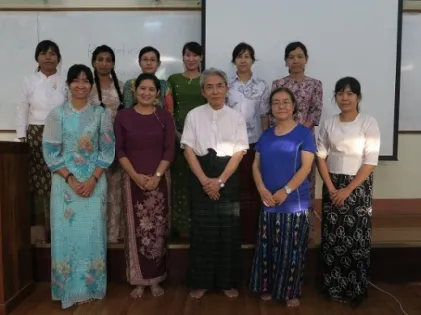
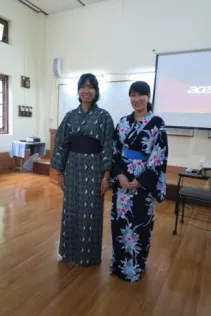
■■■News from the Japanese Language Classroom (August)■■■
Dr. Sumiyo Inamura, Japanese-Instructor
Yangon is in the height of the rain season. Each day brings heavy rain and light rain that falls and ceases. The low roads surrounding the teaching staffs’ living quarters are submerged in water, and some places have become like rivers, but one is still able to walk in the surrounding vicinity of the university. If one walks off the pavement their feet will become stuck in mud.
The rain was severe at 3:30pm at the time of class starting, and as one would expect the students’ attendance rate fell greatly. The Japanese language students entered the classroom drenched by the rain, and as the violent sound of the rain barraged the eaves of the roof, students enthusiastically continued their language studies, with voices saying “I like Japanese cooking” and “I understand a little bit of Japanese”.
For the months of June and July, Ms. Aki Tamura, who contributed to the teaching of Japanese language with youthful power, although greatly valuing the students, had to return to her post on August 15th.
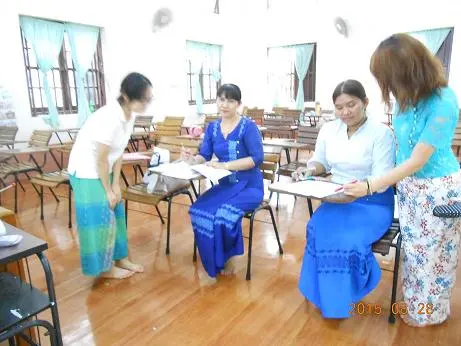
Japanese exchange students communicating with students
I was in charge of the classes in August and September and taught 4 different classes of varying levels. The class textbooks focused on varying levels of Japanese grammar, which progressed as: Monday beginning at Chapter 4, Tuesday beginning at chapter 8, Thursday beginning at Chapter 5 and Friday beginning at Chapter 6. Japanese character classes were for those starting from scratch, focusing on reading and writing, and which brought in Hiragana. Katakana has just been introduced.
10 first year students majoring in Burmese language who arrived in Yangon on August 9th hold an interest in Japanese-language education, and so observed the language classes, as well participating in classes such as engaging in roleplaying while listening to the students’ efforts to respond. The Burmese students are still studying to be accepted as exchange students, but they have successfully been able to communicate with students of Japanese language by working hard to engage in conversation.
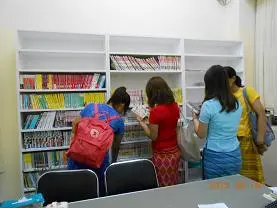
Japanese exchange students gazing at the books in the Yangon GJO library
On Wednesday 26th August 3pm-4pm, Professor Okano, who established Yangon GJO, held a lecture relating to Japanese language and Japanese culture along with the Burmese teaching staff of TUFS. The lecture, which was held in Burmese, was a great success, and was attended by those studying Burmese literature at the University of Yangon, teachers, and Japanese exchange students from TUFS. Japanese greetings such as “Konnichiwa” (“Hello”/”Good afternoon”) and “Ohayou” (“Good morning”) were used during the lesson, and the exchange students were able to change their greetings depending on the status of the person they were taking to, such as friends and teachers, as they roleplayed. The students laughed as they listened to an explanation of the difference between the Burmese language provided by Professor Okano. The students learned much from the 60 minute lecture, where the context of words even such as “Ohayou” was explained against the background of rich Japanese culture.
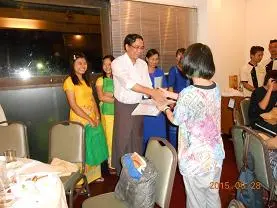
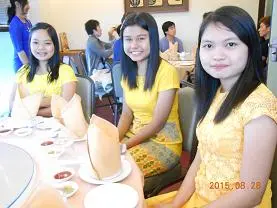
■■■News from the Japanese Language Classroom (July)■■■
The number of students who attended the Monday class and Wednesday class stabilized to 35. The students began learning Hiragana little by little since June, and after finally learning each character, a surprise Hiragana listening test was held during Monday’s class. In spite of the test being given without warning, the majority of students obtained a perfect score and their endeavors from studying at home were clear to see. Moreover, the students were able to enjoy reviewing Hiragana as they were split into groups of 4-5 people to play Hiragana karuta (a type of Japanese card game). Even though the students prefer Hiragana over Katakana (perhaps because it is closer to Burmese script?) they would like to learn Katakana this way too.
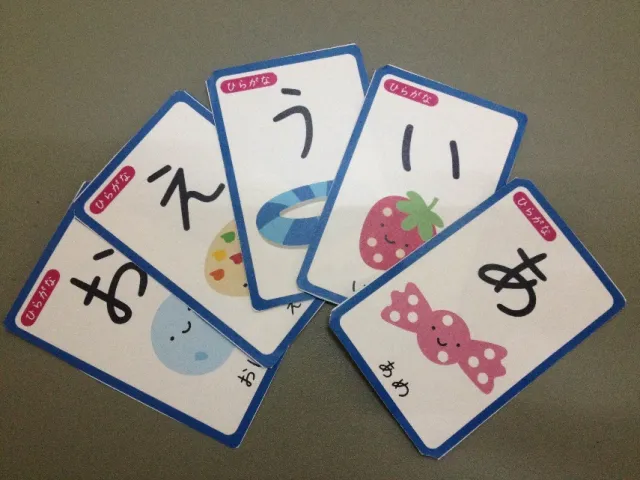
Hiragana karuta cards used in the class
A Japanese film was screen at the Japanese embassy in the middle of July. I went to see a film titled Himitsu no Hanazono (eng: My Secret Cache) with the students of the Tuesday class after lessons had finished. The students often glanced at their admission passes and would ask with curiosity “What is this Kanji?” at the entrance of the Japanese embassy. Even during the screening of the film, the students would whisper in a quiet voice if a word which they knew appeared, so not only did the students enjoy the film, their motivation to learn was felt as they constantly paid attention to and noticed the Japanese used.
Additionally, an arrangement was made in which books and manga were donated by TUFS, so the University of Yangon GJO was able to establish their own library full of Japanese books and manga. The students stared in wonder as the library began to fill with books and manga written in Japanese. Their interest deepened as they stretched out their hands to reach for the books. Undoubtedly, the manga was very popular. However, a lot of the manga that was donated is manga that is filled with nostalgia, such as Urusei Yatsura and YAWARA!, so it is not something that the students are familiar with. I hope it will become part of their interests.
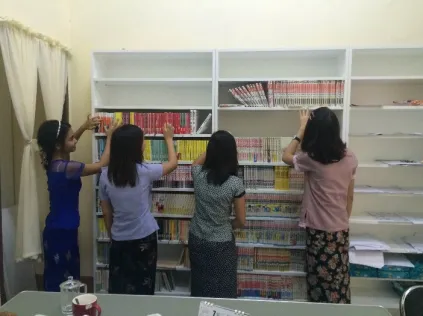
日本語の本を眺める学生たち
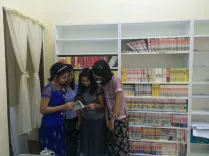
知っている日本語を探している様子
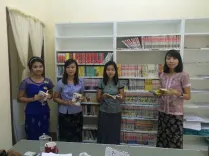
各々興味のある本を手にしています
■■■News from the Japanese Classroom (June)■■■
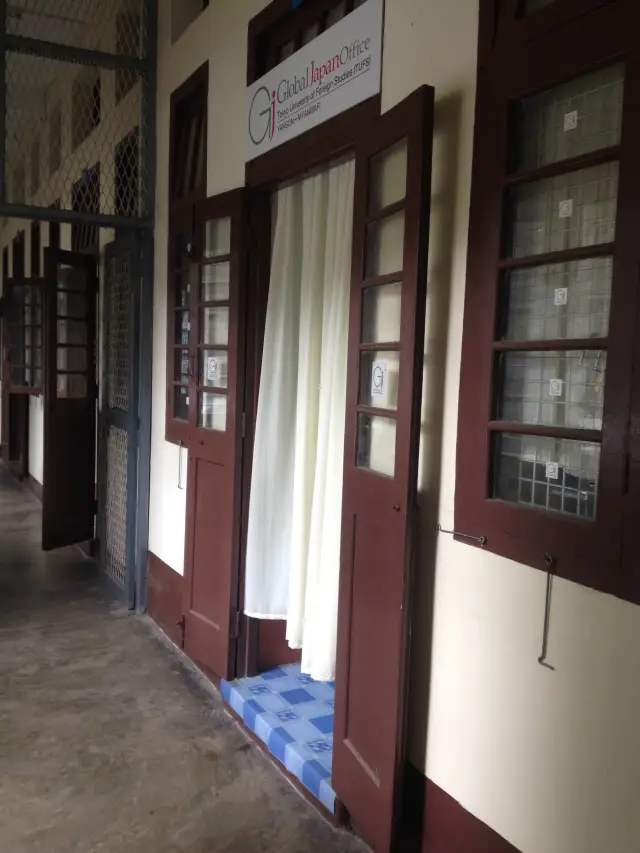
June – the University of Yangon has begun its second semester. In accordance with this, the number of applicants to study Japanese has increased substantially. In the first semester, it was mainly those studying Myanmar who wished to study Japanese, but this semester has seen interest crossing over even to those who are majoring in science. The number of teachers hoping to study Japanese continued to increased, surpassing 100 applicants. Classes have been divided into 4 due to a number of reasons, including there being a difference in language ability between those who have continued studying Japanese language from the previous semester and those beginning their studies, because there is a limitation on the amount of study time, and because there is only 1 teacher. Therefore, it has been decided that each class will be held once a week for 90 minutes. Since the number of class held has decreased, more homework is handed out. Below is an outline of how the classes are divided.
Elementary Level 0 = For those who are new to learning Japanese. They will learn Hiragana and Katakana.
Elementary Level 1 = For those continuing on from the first semester. They have completed Hiragana and Katakana.
• Monday class – Elementary Level 0 – approx. 70 attendees
• Tuesday class – Elementary Level 1 – approx. 15 attendees
• (Wednesdays are limited to June in which lectures regarding Japanese culture are held by Professor Okano)
• Thursday class – Elementary Level 0 – approx. 70 attendees
• Friday class – Elementary Level 1 – approx. 10 attendees
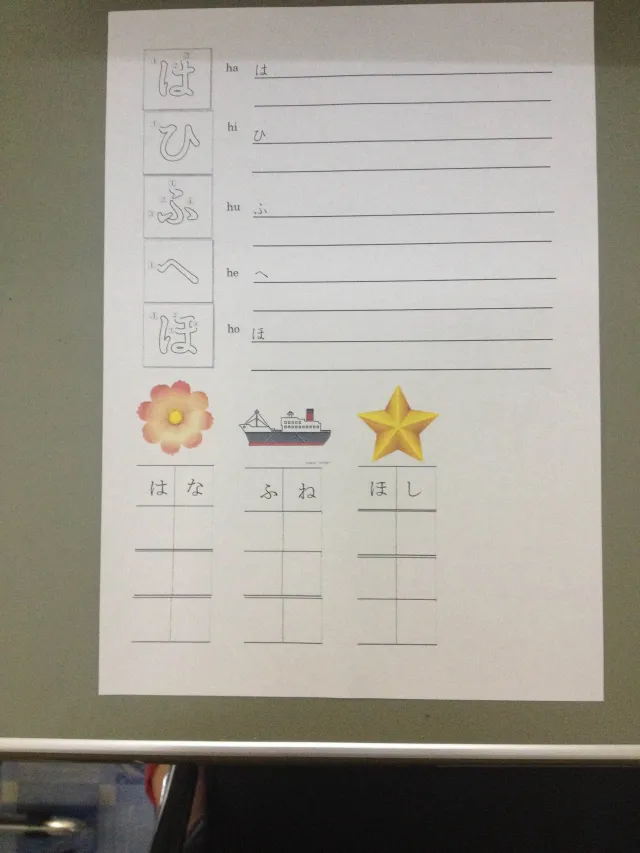
I am overwhelmingly happy at the number of people who are interested in learning Japanese. It has become difficult to focus on each individual, but with such great help from the exchange students at TUFS I think it is something I want to continue with.
For the duration of the 90 minutes in the Elementary Level 0 class, students study grammar, conversation and the Japanese alphabet (starting with Hiragana). The other day when studying the “na” row of characters, we used the example of “inu” (dog) and “neko” (cat). There are many stray cats and dogs – you can even spot them around the university. Upon finishing class, students left the classroom and encountered a playful dog, and said happily “Inu! Inu desu!” (“A dog! It’s a dog!”). They tried out using a new word they had learned. That’s an important method to use in language learning. Although they have a lot of Japanese to learn, it seemed like the students wanted to begin to use the language more.
